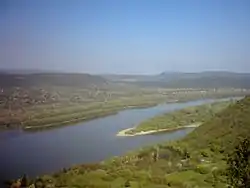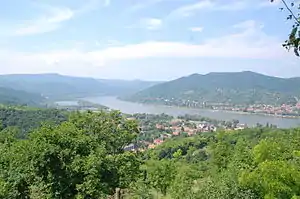Danube Bend
The Danube Bend (Hungarian Dunakanyar) is a curve of the Danube in Hungary, close to the city of Visegrád.
Geology
The present-day U-shaped loop is probably the result of an eruption of the volcano stretching over the whole area some 15 million years ago. The caldera of Keserűs Hill-volcano, with the associated lava dome formed a later eroded central depression in the north. The river follows the southern edge of this caldera.[1]
The region
This region is touristically very significant. The landscape and the river attracts a lot of visitors both from the homeland and abroad. The most important towns are Visegrád, Szentendre and Budapest, while on the other (left) bank of the river can be found Vác, Nagymaros and some smaller towns, villages. The islands of the region are also interesting, mainly the large Szentendrei-sziget and Margaret Island (Margitsziget) within the capital city.
Gallery
 The Cathedral of Vác
The Cathedral of Vác Szentendrei-sziget
Szentendrei-sziget The river near Visegrád
The river near Visegrád.jpg.webp) Szentendre
Szentendre Margaret Island in Budapest
Margaret Island in Budapest
References
- Karátson, Dávid (2015). "Danube Bend: Miocene Half-Caldera and Pleistocene Gorge". Landscapes and Landforms of Hungary. World Geomorphological Landscapes. Springer, Cham. pp. 129–137. doi:10.1007/978-3-319-08997-3_16. ISBN 978-3-319-08996-6.
